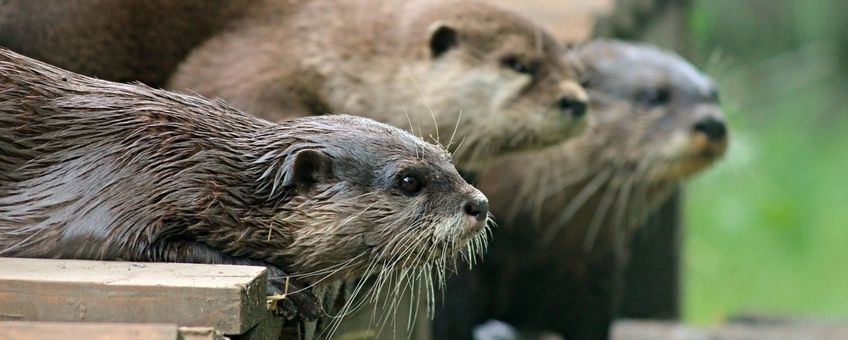
Otter Tupperware party we threw reveals how animals copy each other to learn
The ConversationOne question that has fascinated scientists is whether otters have an innate tendency to bash rocks and clams together or if they learn the practice from their mothers. A recent study indicated that sea otters have been using tools for thousands of years and suggests that this ability is probably innate.
But not all sea otters use tools. A study of what factors predict their tool use found that – besides sex, age, feeding habitats and availability of prey – learning from their mother may also contribute to a sea otter’s tool use. But whether sea otters or any of the other 12 otter species are actually capable of learning from others was still unknown.
To address this question, my colleagues Zosia Ladds, William Hoppitt and I investigated whether otters can solve problems by watching and copying each other, exhibiting what’s known as 'social learning'. Our results suggest that some otters can indeed learn from each other but that not all species do.

This could have important implications for conservation. If we could find a way to make use of this learning ability among captive otters, it might help increase their chances of survival in nature.
Our investigation involved two otter species that, unlike the sea otter, are available to study in zoos and wildlife centres across the UK: smooth-coated otters and Asian short-clawed otters. Both species live in family groups in the wild, but limited field observations suggest that they have different feeding habits. While smooth-coated otters hunt cooperatively for fish, Asian short-clawed otters seem to forage mostly individually for crabs and shellfish.
To test whether these otters could learn how to find food from other group members, we presented captive groups with a battery of food puzzles. These puzzles consisted of Tupperware containers of different shapes and sizes baited with otter treats including fish (heads), peanuts, mealworms, chick legs and shrimp.
While most of us can probably open a Tupperware container blindfolded, this is a challenging task for otters. One otter took over three hours to screw a lid off a cylindrical Tupperware container. But the majority of the otters solved most puzzles within 20 minutes.
Social problem solving
We found that, among the smooth-coated otters, those individuals that spent most time together were also most likely to start solving the puzzles together. In other words, the puzzle solutions spread along the smooth-coated otters’ social network, indicating that they were copying each other.
We also found evidence for a 'copy when young' strategy in this species. The offspring in this group were more than six times faster than their parents to solve the tasks. Our data suggest that these youngsters were good at copying their siblings as well as learning from their own experiences with the tasks.
Our data on the Asian short-clawed otters presented a very different picture. We found no evidence that these otters learned from each other to solve the tasks.

This finding makes sense if we consider the animals’ natural history. If they tend to forage on their own in the wild, Asian short-clawed otters may be less inclined to turn to each other for foraging information than the group-hunting smooth-coated otter.
Both species used to be widespread in South and South-East Asia but their global populations have declined by more than 30% in the past 30 years due to major habitat loss and poaching. As a result, both smooth-coated otters and Asian short-clawed otters now have 'vulnerable' status on the International Union for Conservation of Nature (IUCN) Red List of Threatened Species.
We hope that understanding more about how and from whom otters learn may help conservation efforts. We need to know if captive-bred individuals that are released into the wild will copy their wild counterparts to acquire the life skills they need to face new predators such as dogs and other human threats, as well as learning to catch live prey.
It may be that some otters can act as particularly effective role models to spread successful coping mechanisms in wild populations and increase their chances of survival. But first we need to know whether wild populations show similar social learning tendencies to those we observed in captivity. This will be a challenging endeavour given that it’s increasingly rare to spot one of these fascinating creatures in the wild.
The findings of this study are published in the journal Royal Society Open Science
Text: Neeltje Boogert, University of Exeter; originally publiced on The Conversation (Creative Commons)
Photos: Pixabay
